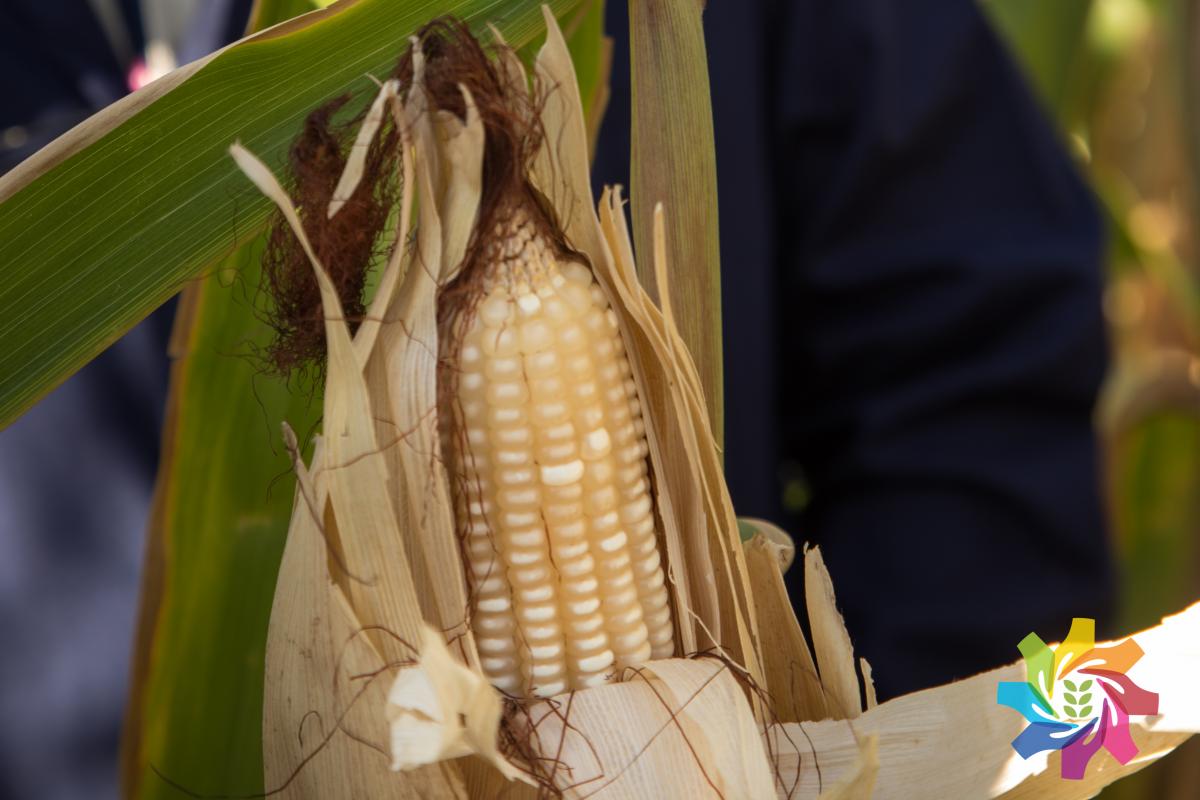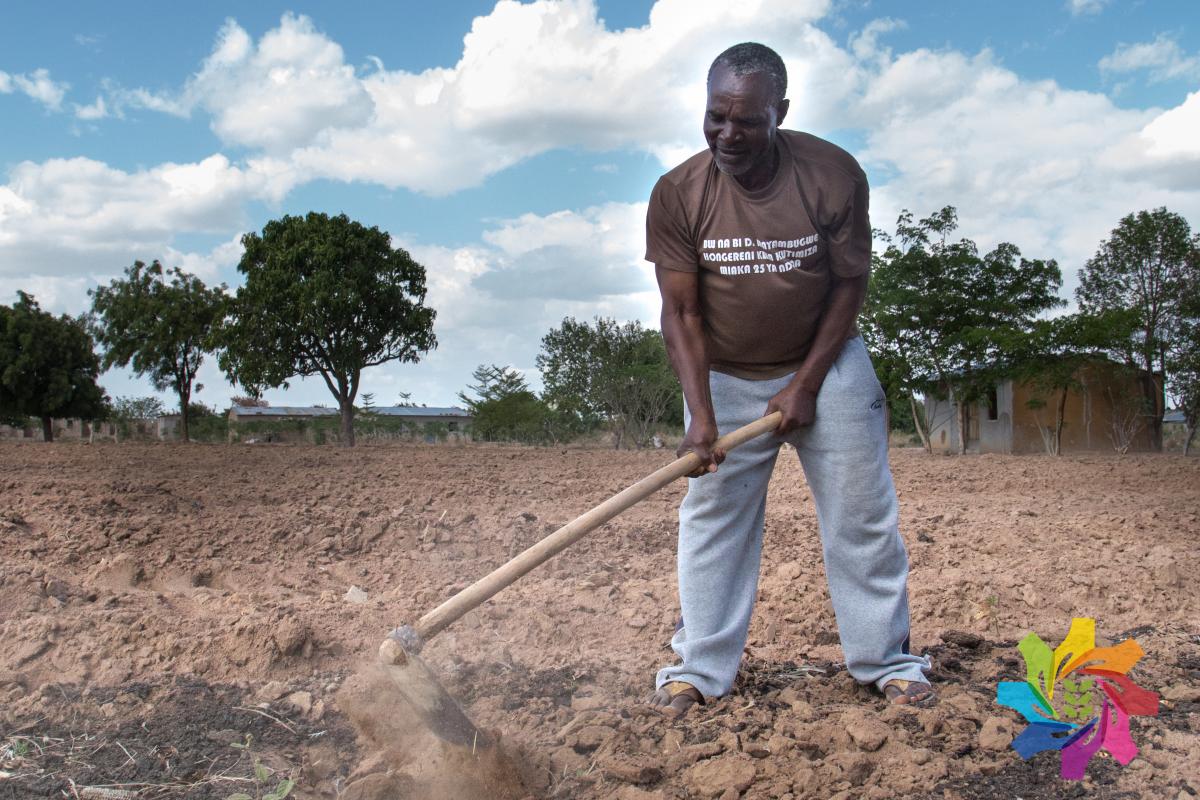 Water Efficient Maize for Africa (WEMA) confined field trial plants in rows for testing gene performance, photo by Hannah Smith Walker
Water Efficient Maize for Africa (WEMA) confined field trial plants in rows for testing gene performance, photo by Hannah Smith WalkerTanzania’s first-ever genetically-modified crop trial was planted only a 30-minute drive from the capital. But saying this might give the wrong impression: Tanzania’s administrative capital is not the 4.3 million-strong coastal city, Dar es Salaam, but the dusty interior town of Dodoma, 8 hours away by road. Although it hosts the parliament building, and a flashy new prime minister’s residence perched on a rocky outcrop above the town, Dodoma has a frontier feel. Goats graze on the roundabouts, and most buildings are low-rise. The town of 400,000 people fades imperceptibly into the surrounding drought-parched countryside, where cultivated fields and small homesteads are set back from the road. We take the road heading north, which will take us to the maize research site at Makutupora.
 WEMA test plants prior to harvesting in the Makutupora confined field trial (CFT), photo by Hannah Smith Walker
WEMA test plants prior to harvesting in the Makutupora confined field trial (CFT), photo by Hannah Smith WalkerOnly a few miles out of town we take a sharp right turn down a track that is so thick with red sand it reminds me of a road to the beach. There is no indication something of real historical significance lies at the end of the road. A year ago the Tanzanian government relaxed the previous strict liability biosafety regime which had de-facto prevented any plant scientists from testing genetically engineered crops outside the lab. The confined field trial (CFT) we are about to visit is the result: the first-ever GMO outdoor trial in the country. Alliance for Science photographer Hannah Smith Walker and I are part of a well-organized and constant stream of visitors: senior government officials, national media and farmers have all been given the tour.
 WEMA researchers show Mark Lynas from the Alliance for Science around the CFT, photo by Hannah Smith Walker
WEMA researchers show Mark Lynas from the Alliance for Science around the CFT, photo by Hannah Smith WalkerThe crop trial itself is located just past some government research buildings, surrounded by a large fence. A sign with large black-and-white lettering outlines the strenuous biosafety rules that still apply: no plants will leave the site, gates must be locked 24/7 and residues of the crop trial must be burned and buried on a trench on site. We are given mandatory blue overalls to put on, a considerable inconvenience under the hot African sun, and required to walk through a pool of disinfectant on the far side of the gate.
 Mark Lynas under the signs at the entrance to the CFT, at Makutupora, Dodoma, photo by Hannah Smith Walker
Mark Lynas under the signs at the entrance to the CFT, at Makutupora, Dodoma, photo by Hannah Smith WalkerThe biosafety regulations are irksome, not least because genetically modified maize of the same type is already being widely distributed and commercially grown in neighboring South Africa. But rules are rules, and all of the researchers I talk to express pride at the trial s progress, and what they have achieved so far.
The timing is propitious, too. The crop being tested was developed by Water Efficient Maize for Africa (WEMA), a regional project funded by the Bill & Melinda Gates Foundation, Howard G. Buffett Foundation and the United States Agency for International Development (USAID) in five sub-Saharan African countries (Kenya, Uganda, Tanzania, Mozambique and South Africa), and carried out by the Nairobi-based African Agricultural Technology Foundation, in partnership with national plant science and agricultural institutes and ministries. The entire region is currently in the grip of a severe drought, and farmers are suffering serious food shortages in many areas. Maize, a comparatively thirsty crop, but an important staple food across the region, is being hit particularly hard.
 Close up of a mature maize cob in the WEMA CFT, photo by Hannah Smith Walker
Close up of a mature maize cob in the WEMA CFT, photo by Hannah Smith WalkerHence the rationale for the project to breed hybrid maize seeds genetically engineered with a gene to help them tolerate water-stress during the all-important flowering and seed-filling stage is obvious to everyone. Conventionally bred drought-tolerant maize is already being distributed to farmers under the trade name Drought TEGO. But the GM variety genetically stacked with the insect-resistance Bt gene, as well as the conventional drought trait could be a game-changer in improving the resilience of smallholder farmers to droughts aggravated by climate change.
 WEMA Tanzania technical advisor, Dr Alois Kullaya, photo by Hannah Smith Walker
WEMA Tanzania technical advisor, Dr Alois Kullaya, photo by Hannah Smith WalkerWEMA’s Tanzania technical advisor, Dr. Alois Kullaya, is our main guide. Although he is careful not to prejudge the scientific results from the trial, he is confident just from the look of the crop that the drought gene is performing well. “From the general appearances, we think the genetically modified drought tolerant hybrids are going to do better than the non genetically modified,” he tells me. “We can say for sure when we have harvested and when the results are out. But it looks very convincing.”
I carefully inspect one of the cobs, helpfully labelled GMO for visiting non-expert eyes. Kullaya has told me that these plants, while grown in optimal conditions in terms of fertilizer and soil, were water-stressed for a whole month starting at the onset of flowering. Yet the kernels look fat and impressive, arranged in neat, densely-packed rows.
 Close up on a mature WEMA maize cob, showing GMO test plant label, photo by Hannah Smith Walker
Close up on a mature WEMA maize cob, showing GMO test plant label, photo by Hannah Smith WalkerThe plants overall are tall and straight, easily the best-looking maize plants I have seen anywhere in Tanzania in a week of travel visiting several regions. However, it will be a while before drought-stressed farmers have a chance to grow them. Dr. Kullaya tells me that even if the gene performs well in the CFT, two more years of multiple-location trials will still be necessary to check agronomic and ecological performance in different regions of the country. Plus, the strict liability regime has only so far been removed for research in Tanzania and not full environmental release; this additional bureaucratic hindrance would also need to be removed for the WEMA crop to proceed to full commercialization, as it has in South Africa. So the projected launch date is 2021, though this could conceivably be brought forward if regional Southern African Development Community seed rules can be invoked in order to avoid time-consuming and repetitive country-by-country assessments.
However, all WEMA countries, apart from South Africa, have seen political roadblocks placed in the way of farmers being able to access the improved seeds: Kenya has a lingering ban on GMO imports placed in 2012 in response to the now-discredited Seralini paper; Uganda has had years of political deadlock over a proposed biosafety law, and Mozambique until recently had the same out-of-date strict liability regime as Tanzania, but expects to plant its first ever CFT in February 2017 after a long delay because of plant import permits.
It is a bitter irony that ideologically-motivated opponents have assiduously blocked improved seeds in all these countries, where they could provide the most benefit to some of the poorest farmers in the world. Somehow they ve missed the obvious fact that small, resource-poor farmers are the intended beneficiaries of WEMA. The drought-tolerance gene could most benefit farmers without the capital to afford irrigation infrastructure, who grow rain-fed crops and thereby run the risk of harvest losses when rains fail. Some 95 percent of Tanzania’s maize is grown by such farmers, who will be offered the seeds at prices comparable to conventional maize seed, according to Dr. Kullaya.
 Farmer Justin Kafyulilo, whose maize field has been too dry to cultivate. Veyula village, Dodoma region, photo by Hannah Smith Walker
Farmer Justin Kafyulilo, whose maize field has been too dry to cultivate. Veyula village, Dodoma region, photo by Hannah Smith WalkerAmerica’s capital-intensive corn belt is a world away from this small-holder agriculture, where most, if not all, of the work is still carried out by hand. This is a point emphasized by Dr. Nicholas Nyange, an advisor working with the Tanzanian branch of the Open Forum for Agricultural Biotechnology in Africa (OFAB). “When you look at our subsistence farmers in Tanzania, most of them they use hand hoes, and very few are privileged to use tractors,” he tells me. “So even though I find they cannot have access to good technological machines, if we can have the right seed for them, though using their hand hoe, at least they can harvest something.”
 Farmer Salma Seleman with her drought-failed maize crop. Chambezi village, Bagamoyo, Tanzania, photo by Hannah Smith Walker
Farmer Salma Seleman with her drought-failed maize crop. Chambezi village, Bagamoyo, Tanzania, photo by Hannah Smith WalkerDr. Nyange describes for me the typical subsistence farm: “Actually, the typical size of a farm in Tanzania, the smallholders, we are talking about less than 3 acres.” Most of those doing farm work are women, he points out. Improved seeds, and agricultural development in general, is clearly aimed at reducing rural poverty. “So that they are able to sell whatever they grow as surplus and have enough income so that they can support their families,” Nyange explains.
 Group photograph of WEMA officials and visitors at the CFT, Makutupora, Dodoma, photo by Hannah Smith Walker
Group photograph of WEMA officials and visitors at the CFT, Makutupora, Dodoma, photo by Hannah Smith WalkerAs we line up for a group photograph in the golden sunlight of the evening, the gentle breeze makes the drying corn leaves rustle pleasantly and there is a sense of optimism in the air. Using science to benefit the poorest is a passion shared by all the researchers, who are united in a feeling of pride that smallholder farmers in Tanzania should soon be able to benefit from their work.
